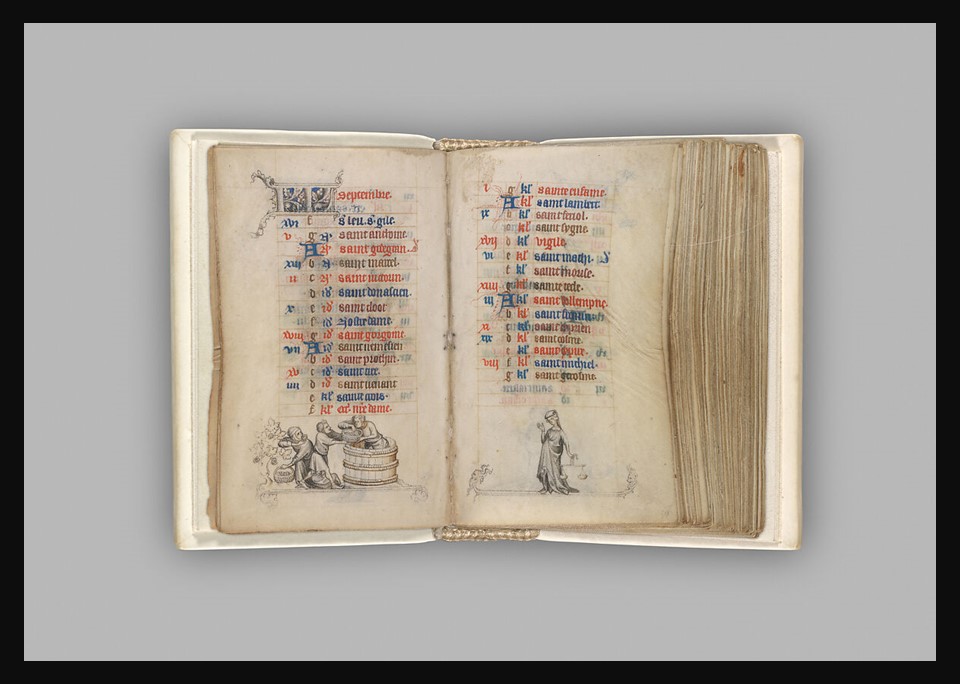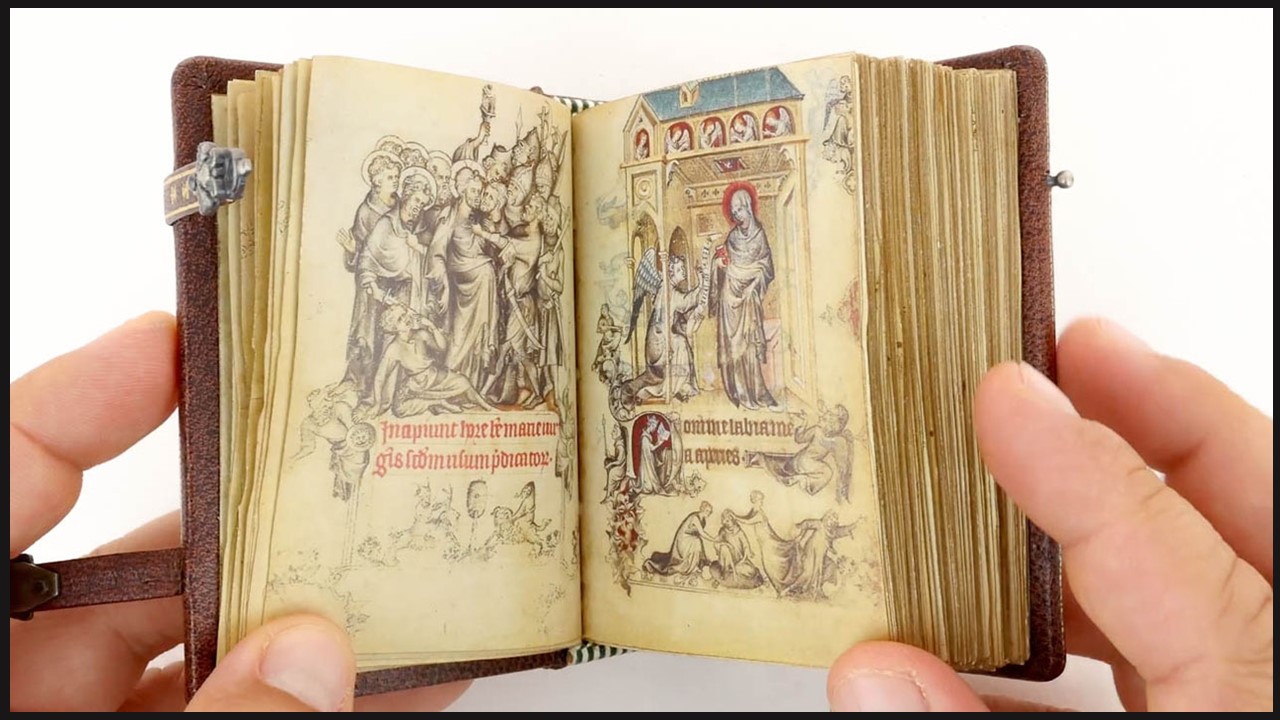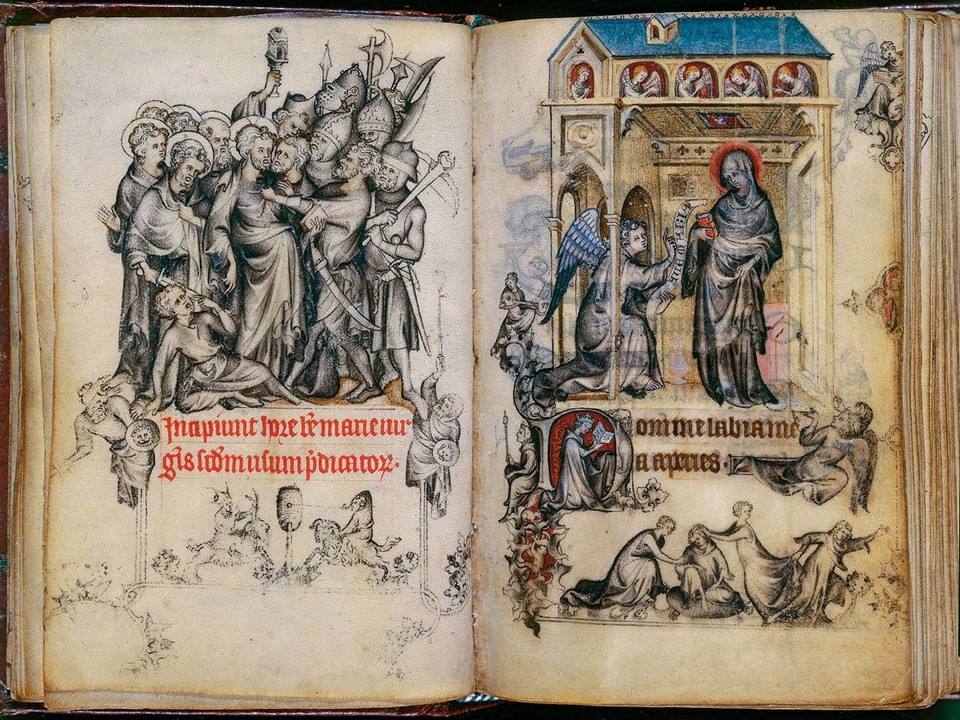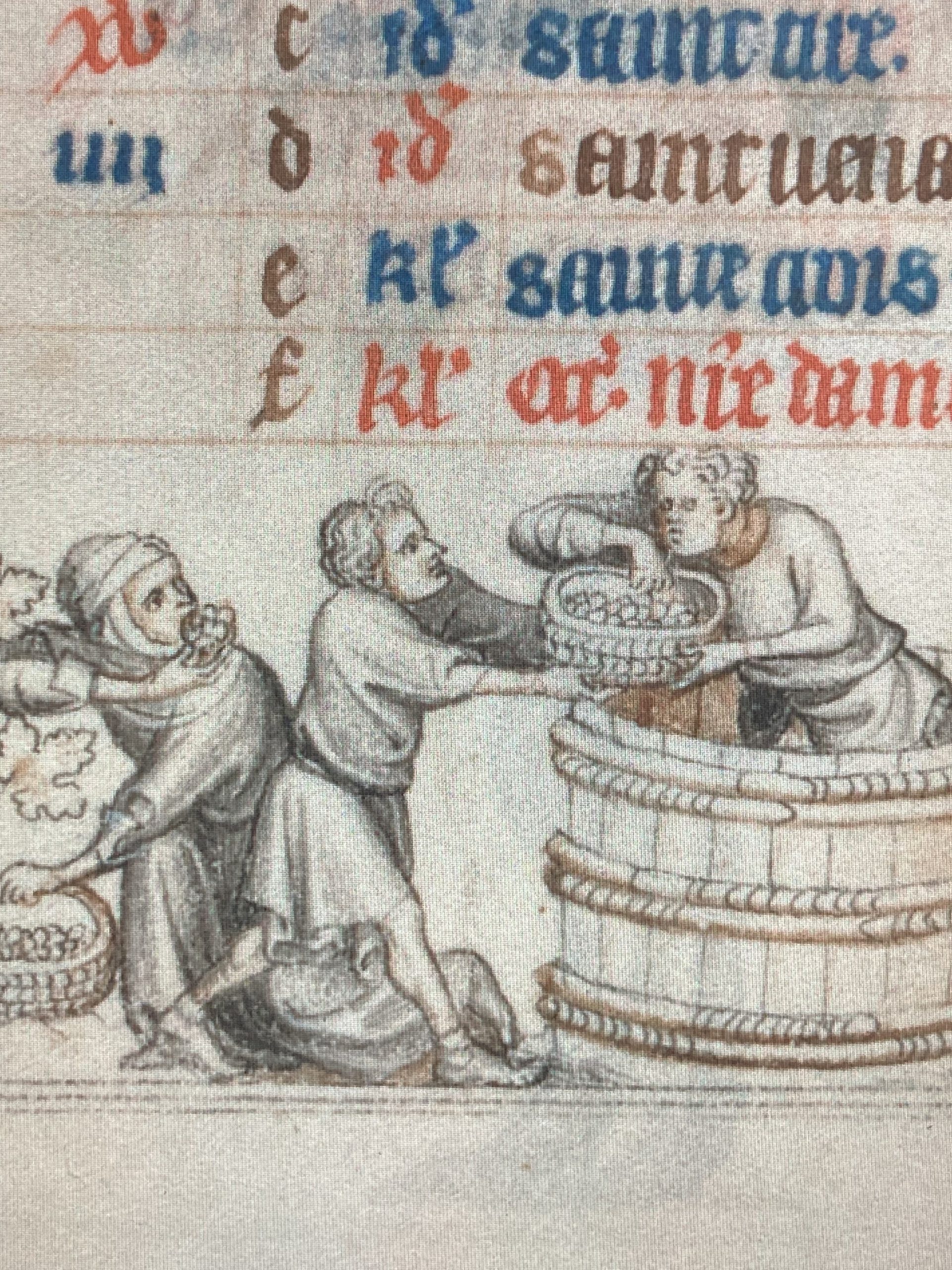
The Hours of Jeanne d’Evreux, Queen of France, Folios 9v-10r, Calendar Pages for September, ca. 1324-28, Grisaille, tempera, and ink on vellum, Single folio: 9.2 x 6.2 cm, the MET, NY, USA Jean Pucelle | The Hours of Jeanne d’Evreux, Queen of France | French | The Metropolitan Museum of Art (metmuseum.org)
The Hours of Jeanne d’Evreux, Queen of France, is a famous medieval illuminated manuscript created around the year 1324-1328. Currently housed in the collection of the Metropolitan Museum of Art in New York City, on display at the Cloisters, the manuscript is considered one of the most exquisite examples of Late Gothic manuscript illumination. It was probably commissioned for Jeanne d’Evreux, by her husband, King Charles IV of France, between the date of their marriage in 1325 and his death three years later.
At first glance, this tiny prayer book, the size of each vellum folio is 9.2 x 6.2 cm, with not a trace of gold, might seem an unlikely possession for a queen of France. The Hours of Jeanne d’Evreux, however, offers much more than meets the eye. This manuscript consists of 209 folios, containing not only twenty-five full-page paintings featuring depictions of significant moments from the Infancy and Passion of Christ, but also scenes portraying the life of Saint Louis, a notable ancestor of Queen Jeanne. Additionally, the margins of the manuscript are adorned with an astonishing array of nearly 700 illustrations. These illustrations vividly portray a diverse tapestry of medieval Parisian society, including bishops, beggars, street dancers, maidens, and musicians. Furthermore, interspersed among these depictions are whimsical creatures from the realm of pure fantasy, such as apes, rabbits, dogs, and other enigmatic beings. The combination of meticulously crafted religious imagery and glimpses into the vibrant urban life of medieval Paris makes The Hours of Jeanne d’Evreux an extraordinary testament to the artistic and cultural milieu of the time. https://www.metmuseum.org/art/collection/search/470309


The Hours of Jeanne d’Evreux, Queen of France, Folios 15v-16r, The Betrayal of Christ and The Annunciation to Mary, 1324-28, Grisaille, tempera, and ink on vellum, Single folio: 9.2 x 6.2 cm, the MET, NY, USA https://commons.wikimedia.org/wiki/File:4_Jean_Pucelle._Hours_of_Jeanne_d%27Evreux._1325-28,_Metropolitan_Museum,_New-York.jpg
While there is no positive proof establishing the identity of the artist behind the Cloisters manuscript, three extraordinary documents, Jeanne d’Evreux’s will, King Charles V’s inventory of treasures, and the successive 1401 and 1406 inventories of the collection of Jean, Duc de Berry, led scholars to accept Jean Pucelle as the artistic genius behind the manuscript’s illuminations.
Jean Pucelle was a fine Parisian manuscript illuminator of impeccable taste and refined elegance. He was a great innovator, introducing the art of Giotto and Ducio to Northern Europe. He had the ability to present sculpturally modeled figures, capture psychological expressions, and convey human emotions. Finally, Pucelle was the artist who presented ideas such as the use of naturalistic settings and narrative continuity within his miniatures.
His name became synonymous with exceptional craftsmanship and artistic excellence, but much of his life remains shrouded in mystery. However, his surviving works serve as a testament to his profound impact on the art of illumination during the medieval period, earning him a well-deserved place among the great masters of the era.
The illuminated manuscript of Jeanne d’Evreux in the Cloisters is a Book of Hours, that is, a devotional and instructional book that was popular in Western Europe during the Middle Ages. It was primarily used by laypeople, particularly wealthy individuals, for personal prayer and devotion. It was essentially a private prayer book, containing a collection of prayers, psalms, hymns, and other religious texts, often accompanied by illustrations. It was called a “Book of Hours” because it typically included a series of prayers that were meant to be recited at specific times throughout the day, corresponding to the canonical hours of the liturgical day.
The book usually began with a calendar, which listed important feast days and saints’ days. It would then include various sections, such as the Hours of the Virgin Mary, the Office of the Dead, and other prayers dedicated to specific saints or events. Each section would contain specific prayers, psalms, and readings associated with the particular devotion.
The decoration for the Calendar page in Books of Hours can vary depending on the specific manuscript and the artistic style of the time. For The Hours of Jeanne d’Evreux, Pucelle employed scenes depicting the agricultural activities commonly carried out each month of the year, such as plowing, sowing seeds, or tending to crops, along with scenes of the countryside, fields, or farms. For the Month of September, the artist chose to depict the labor of harvesting or tending to the vineyards. Pucelle’s page shows workers engaged in grape harvesting and winemaking activities, such as picking grapes, stomping on them, and hungrily tasting the fruits of their labour.

The Hours of Jeanne d’Evreux, Queen of France, Folios 9v-10r (detail), Calendar Pages for September, ca. 1324-28, Grisaille, tempera, and ink on vellum, Single folio: 9.2 x 6.2 cm, the MET, NY, USA Jean Pucelle | The Hours of Jeanne d’Evreux, Queen of France | French | The Metropolitan Museum of Art (metmuseum.org)
What I like most is how the illuminations created for the Hours of Jeanne d’Evreux employ a diverse range of artistic techniques. One of them is the grisaille technique, described as de blanc et noir in French, which involves using shades of gray created through hatching and cross-hatching. Grisaille, however, is not enough for Jean Pucelle. He wants to introduce vibrant colours, so along with grisaille, he adds tempera paints as well. The combination of these two techniques, known as “camaïeu gris,” results in a harmonious interplay of grayscale and color. The application of grisaille and the skillful use of tempera bring forth a visually captivating effect, enhancing the overall aesthetic appeal of the manuscript.
Overall, the Hours of Jeanne d’Evreux is not only a masterpiece of medieval art, characterized by its elegant figures, attention to detail, and a fusion of naturalistic and stylized elements. It is a valuable historical artifact as well, providing insight into the artistic, cultural, and religious practices of the French royal court during the 14th century.
Its delicate illuminations and meticulous craftsmanship make it a treasured example of medieval book art, and it continues to inspire and captivate viewers to this day.
For a Student Activity, please… Check HERE!